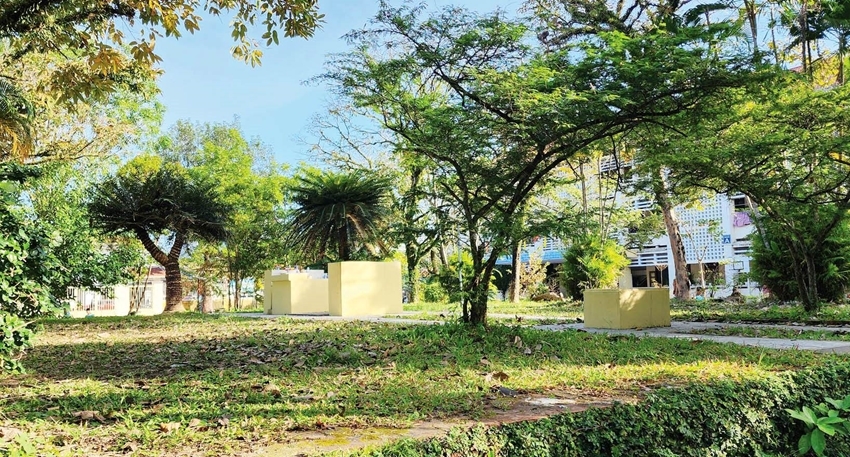 |
| Son Xuyen Esplanade faces south |
Over 170 years have passed, yet the esplanade still stands amidst moss-covered silence, right next to the bustling Bui Thi Xuan street. The esplanade is in plain sight, nestled within the Phuong Duc Primary School grounds, surrounded by lush trees and wild grass.
Son Xuyen is an esplanade dedicated to the mountain and river deities in each locality, praying for favorable rain, peaceful winds, and abundant harvests. According to the National Archives Center I, there is no historical documentation mentioning the construction of the Son Xuyen Esplanade before the Nguyen dynasty. It was not until "the 21st year of Minh Mang (1840) that the 'danh son dai xuyen' esplanades were established."
Records state that in each province, after the imperial court organized worship ceremonies, the sites were usually dismantled rather than solidified, unlike the Son Xuyen Esplanade in Hue. Specifically, the Son Xuyen Esplanade in Thua Thien prefecture was built in the 6th year of Tu Duc (1853), following the orders of the magistrate to construct an esplanade in the Bo Hoa Thuong region, located in Duong Xuan Thuong village, Huong Thuy district (now part of the Phuong Duc Ward, Hue City).
The esplanade is surrounded by coarse brick and mountain stone walls, with the center filled with compacted soil, "facing south, worshiping the high mountain and grand river deities." The esplanade consists of two levels: the upper level with a central area about 22x22m and a height of over 1m; the lower level with a width of 45x45m and a height of nearly 0.5m.
Imperial records from the Nguyen dynasty and the Kham dinh Dai Nam Hoi book of customs note the regulations on rituals and offerings at the esplanade. In the 4th year of Tu Duc (1851), the Ministry of Rites proposed to standardize the ceremonies and offerings at various esplanades, including Son Xuyen: "rituals and offerings at the Xa Tac, Tien Nong, Hoi Dong shrines, Son Xuyen Esplanade, and river deity shrine, were inconsistent..."
In the 1st year of Ham Nghi (1885), the Nguyen dynasty specified offerings for the Son Xuyen Esplanade: "4 offerings at the Son Xuyen Esplanade, including 1 ox at the main altar, 1 pig, 1 large tray of glutinous rice, 8 trays of fruits, incense, gold, silver, wine, tea and incense." The Son Xuyen Esplanade was built on elevated land, used for worshiping mountain and river deities. Rituals were held twice a year, in spring and autumn, with Thua Te mandarins participating, dressed in imperial attire. In addition, the Nguyen dynasty also organized rituals at the Son Xuyen Esplanade when the emperor returned from provincial tours, in the 1st year of Dong Khanh (1886); or during major events like the Tan Quang major ceremony in the 1st year of Duy Tan (1907).
Imperial Records also mentioned the Nguyen dynasty carrying out renovations at the Son Xuyen Esplanade. A decree from the Ministry of Public Works on April 15th in the 18th year of Thanh Thai (1906) requested funds for repairing the Son Xuyen Esplanade. However, from then until after 1945, there is no documentation of repairs or rituals at the Son Xuyen Esplanade. In the later period, as the sovereignty of the country increasingly fell into the hands of the French colonialists, the worship of mountain and river deities also lost attention.
According to researcher Phan Thuan An, as one of the 26 famous esplanades worshiping mountain and river deities nationwide, the Son Xuyen Esplanade in Hue may have greater significance in rituals as it is located in a historically significant region. No records mention the Son Xuyen Esplanade being built during the Dinh, Le, Ly, Tran, Hau Le, and Tay Son periods.
In the 5th year of Tu Đuc (1852), the two levels of the Son Xuyen Esplanade were built on an area of approximately 8,410m2. However, this land is currently under the management of the school and private residences. Within the premises of the Phuong Duc Primary School, only the upper level of the esplanade remains above the ground, surrounded by lush greenery. The altars, stone tablets, and inscriptions no longer exist.
Nguyen Xuan Cuong, Vice Principal of Phuong Duc Primary School, expressed that the school consistently educates students about heritage conservation and the significance of the Son Xuyen Esplanade, along with the Voi Re Pavilion - evidence of the once vibrant statue squad of the Nguyen dynasty, located within the Phuong Duc ward's territory. "To collectively protect our heritage, students and teachers regularly clean the esplanade's grounds. We hope that one day soon, the Son Xuyen Esplanade will be restored and enhanced to its original state during the Nguyen dynasty," said Mr. Cuong.
Not as famous and significant as the Nam Giao or Xa Tac Esplanades, the Son Xuyen Esplanade carries profound humanistic meaning, reflecting to some extent the responsibility and concern of the imperial court for the material and spiritual life of the people. It demonstrates the diversity of spiritual life and the longing for peace in the lives of the people in the Ancient Capital. Therefore, preserving, enhancing, and promoting the value of the Son Xuyen Esplanade is a necessary and important task to preserve the historical and cultural values of the nation, as well as to educate the spirit for future generations.